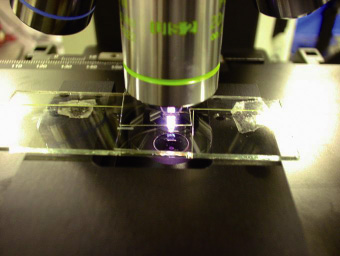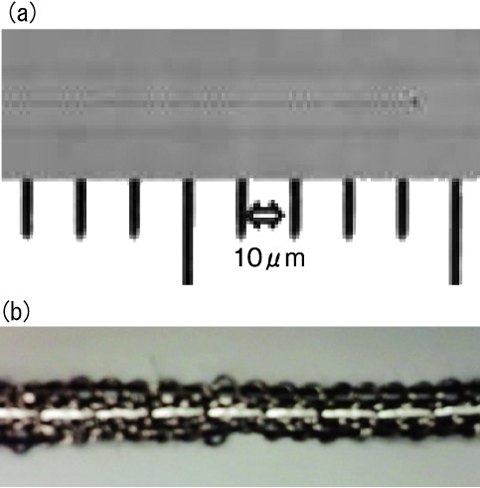
Fig.14-1 Laser fine processing

Fig.14-2 FBG along the fiber core and woven carbon fibers

Fig.14-3 Attachment test and loading test of the FBG sensor on a mock-up pipe
It is very important to understand the seismic deformation of aging piping systems. For this reason, we developed prototype seismic sensors with optical fiber Bragg grating (FBG) using femtosecond laser processing. FBG sensors have periodic refractive index change in their core fiber. The refractive index change in the core fiber actually functions as a wavelength tunable reflection mirror. A fiber cable installed along a complex piping system can detect a deformation when there is a strong earthquake. The fiber laser monitor observes the wavelength shift of the reflection spectrum peak.
Two methods of FBG fabrication are well known: interference exposure and direct writing. Commercially available FBG sensors are commonly produced by interference exposure, and operation in high temperature conditions cannot help but degrade these FBG sensors. We improved the direct writing FBG fabrication method, which can produce structures with superior heat resistance. Fig.14-1 shows microscopic focusing on silica glass optical fiber. Temperature at the focus point rapidly increased to the melting point in picoseconds. Thermal expansion and cooling solidification generate changes in density where the density becomes lower at the center of the molten zone. This density change is strong enough to be maintained for a long time, which is shown in Fig.14-2(a). Ultraviolet laser pulses necessarily damage the surface layer of the optical fiber before they reach the optical fiber core, and nanosecond laser pulses cause thermal damage. In our processing, infrared femtosecond laser pulses can work well, just like a “light engraver,” only for the optical fiber core, without causing thermal damage.
In addition, to combine FBG optical fiber and woven carbon fiber is very important in order to apply it to the surface of a facility’s pipes. It is well known that carbon fiber has high strength and durability. Thus we hope that woven carbon fiber in a tape-like shape will be sufficiently strong and easily handled, which is shown in Fig.14-2 (b).
Moreover, we developed a compact fiber laser as a monitoring light source, which has a wavelength tunable grating at one end of its resonator. It can monitor the center wavelength of the spectrum reflected from the FBG’s structure. We have a plan to apply the FBG sensor to a mock-up piping system such as the FBR secondary coolant system, which is shown in Fig.14-3. In the near future, both real time monitoring by FBG sensors and seismic monitors will be popular for the safe operation of nuclear plants.
<Previous: 14 Development of Experimental Techniques / Facilities at JAEA R&D Centers | Next: 14-2 >